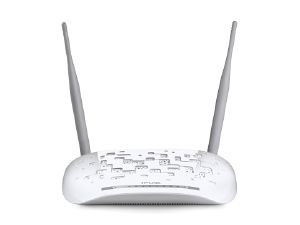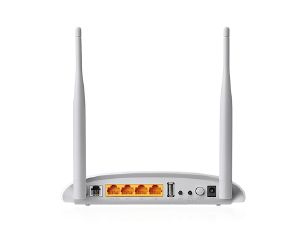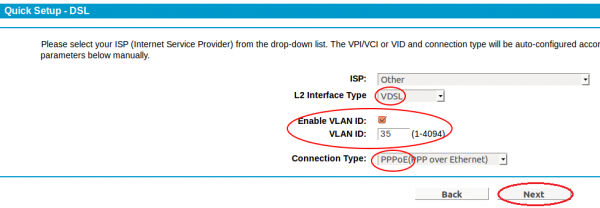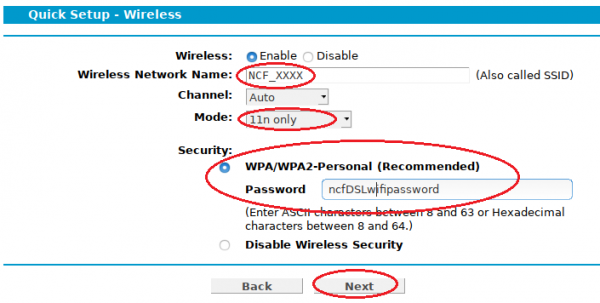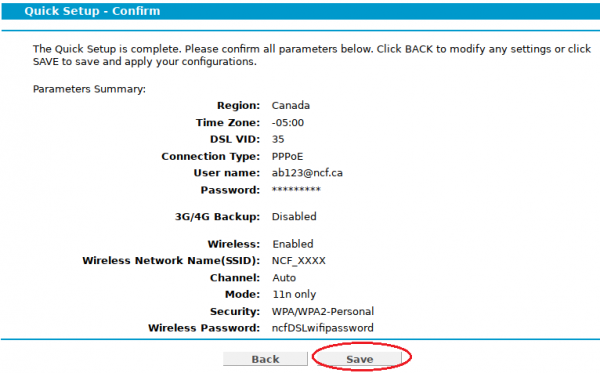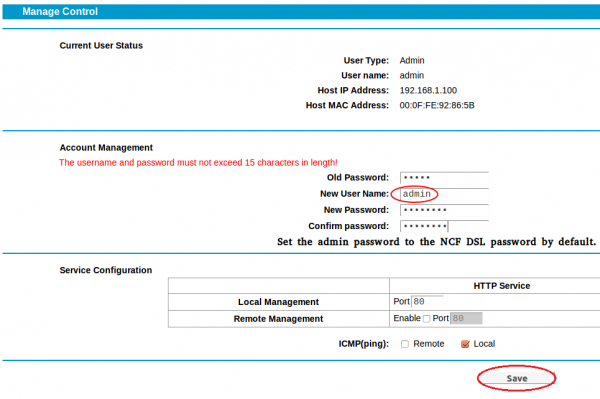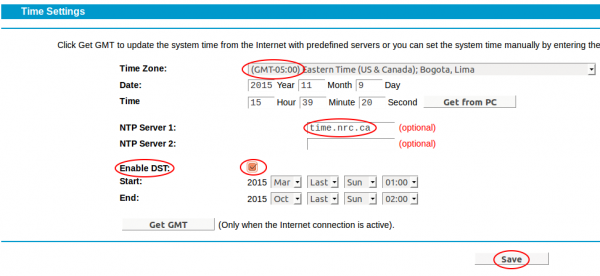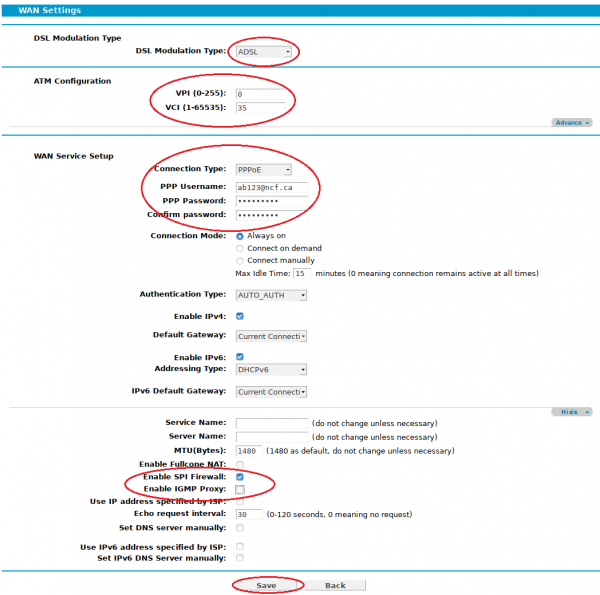Difference between revisions of "TP-Link TD-W9970 Configuration"
| Line 27: | Line 27: | ||
[[file:Td-w9970_setup7.png|600px|Step7]] | [[file:Td-w9970_setup7.png|600px|Step7]] | ||
[[file:Td-w9970_setup8.png|600px|Step8]] | [[file:Td-w9970_setup8.png|600px|Step8]] | ||
<!--=== Wireless Setup ===--> | <!--=== Wireless Setup ===--> | ||
| Line 37: | Line 33: | ||
<!--Click on the "Security" subtab , store the NCF DSL password for the wi-fi password.--> | <!--Click on the "Security" subtab , store the NCF DSL password for the wi-fi password.--> | ||
=== Modem Password Setup === | |||
Click on the "System Tools" link on the LH side of the page, then "Manage Control". Change the modem access password to NCF standard. | |||
[[file:Td-w9970_setup11.png|600px|Setting Admin Password]] | |||
=== Configuring Time Zone === | |||
Click on the "System Tools" link on the LH side of the page, then "Time Settings". Set the timezone to Eastern Standard Time, enable DST (Daylight Savings Time), and set the NTP server to the NRC clocks (time.nrc.ca). | |||
[[file:Td-w9970_setup12.png|600px|Configuring Time Settings]] | |||
=== Add Settings for ADSL Mode=== | === Add Settings for ADSL Mode=== | ||
| Line 58: | Line 50: | ||
* Freedom 15-1/300 | * Freedom 15-1/300 | ||
[[file:Td-w9970_setup9.png|600px|Adding ADSL2+ WAN Config 1/2]] | |||
[[file:Td-w9970_setup10.png|600px|Adding ADSL2+ WAN Config 2/2]] | |||
[[ | |||
== Configure as bridge == | == Configure as bridge == | ||
Revision as of 16:43, 23 December 2015
The TP-Link TD-W9970 is for use on service over 25 MB/s on networks using Bells' DSL infrastructure. NCF sells these modems for members on 25 MB and faster service.
This is the procedure NCF uses to configure a TP-Link TD-W9970 modem out of the box or after a factory reset. To learn more about configuring your particular modem, consult the manual.
Configure router for Dual Mode ADSL/VDSL operation
Your router can support both ADSL mode and VDSL mode. If necessary, you could switch between ADSL plans and VDSL plans without having to buy a new router or even reconfigure your existing one.
Settings for VDSL
We will start with the mode used for VDSL connections. These include the following NCF DSL Plans:
- Freedom 15-10/300
- Freedom 25/300
- Freedom 50/300
Quick Setup
NOTE: If the modem is brand new, "user name: admin and password admin" will gain access. If the modem is not new, it is recommended to reset the modem to the factory defaults by holding down the reset button with a paper clip for 6 to 9 seconds and then do step 1.
1. Once you access the modem browser at 192.168.1.1 and login (user name: admin and password admin), click the link high-lighted in red (Quick Setup).
Modem Password Setup
Click on the "System Tools" link on the LH side of the page, then "Manage Control". Change the modem access password to NCF standard.
Configuring Time Zone
Click on the "System Tools" link on the LH side of the page, then "Time Settings". Set the timezone to Eastern Standard Time, enable DST (Daylight Savings Time), and set the NTP server to the NRC clocks (time.nrc.ca).
Add Settings for ADSL Mode
Moving on now to add settings for ADSL mode. ADSL plans include the following NCF DSL Plans:
- Freedom 6/300
- Freedom 7/300
- Freedom 15-1/300
Configure as bridge
Do this only if you prefer to use your own external router rather than the one built into your TP-Link unit.
- Connect power and turn on the modem with the button on the back.
- Connect an Ethernet LAN cable to one of the yellow rear ports
- In the browser's address bar, enter the IP address for the modem interface page: 192.168.1.1
- If the modem is fresh from the factory, use the default user name and password to gain access
- user: admin
- password: admin
If the modem was previously configured for someone, the password would be the previous user's DSL password. If it is unknown then do a reset to factory default, using a paper-clip in the reset hole on the back. Hold for 6 to 9 seconds to reset. The user name and password will now be as above.
- Click on Advanced Setup and WAN Service and click on Add
- The defaults are fine; click on Next.
- Click on Bridging and ensure the 802.1P and 802.1Q are set to 0 and 35, then click on Next.
- Click on Apply/Save
- Done!
See screenshots below:
Configuring for Bridge Mode 1/5 Configuring for Bridge Mode 2/5 Configuring for Bridge Mode 3/5 Configuring for Bridge Mode 4/5 Configuring for Bridge Mode 5/5
Wireless Configuration
Continuing now to set the Wireless configuration
- Ensure Enable Wireless is checked
- The SSID is set to NCF plus a random number, such as NCF_123456. It is recommended you not use your first or last name, or street address as this information is broadcast and other people in your area will be able to associate the signal with which home it is coming from.
- Click on Apply/Save at the bottom.
- Click on Security on the left.
- Set the Network Authentication to Mixed WPA2/WPA-PSK
- Uncheck Use base MAC address as WPA/WAPI passphrase
- Set the WPA/WAPI passphrase to be your DSL-Password
- Click Apply/save.
Password protect the Admin Role
- Click on Management on the left. Below it other options appear.
- Select Access Control
- Select Passwords
- Enter admin for the User Name
- Enter admin for the Old Password
- For the New Password use your DSL-Password or another strong password.
- Enter it once and again below to confirm
- Save the changes with Apply/Save
Click on "Device Info". A pop-up log-in screen appears, and asks for sign-in. Use the User-ID admin and the DSL-Password just set. Return to the same configure page you were just at.
See also
- TP-Link TD-W9970 modem manual
- NCF TP-Link TD-W9970 modem instruction sheet
- About DSL modem lights - TP-Link modems
- Dynamic DNS
- Modem Configuration (DSL) - for a complete list of instructions for all NCF modems
- Port forwarding

